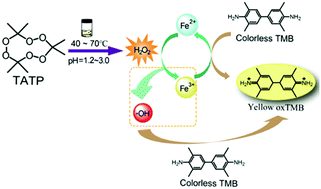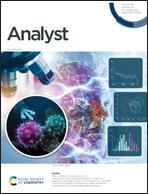Visual colorimetric detection of triacetone triperoxide based on a Fe(ii)-promoted thermal decomposition process†
Abstract
Triacetone triperoxide (TATP) explosives, a popular choice for terrorists, have been used in many violent terrorist attacks all over the world. However, simple, rapid, and on-site detection methods of TATP are still lacking. Herein, we present a visual colorimetric method for on-site and rapid detection of TATP based on a Fe(II)-promoted thermal decomposition process of TATP. We discovered that TATP can be decomposed into H2O2 under heating conditions, and it reacts with Fe2+ to produce hydroxyl radicals (˙OH) and Fe3+via the Fenton reaction. The resulting ˙OH and Fe3+ further oxidize colorless 3,3′,5,5′-tetramethylbenzidine (TMB) to a yellow oxidized product (oxTMB). These reaction processes remarkably promote the chemical equilibrium shift and decrease the activation energy. Using the TATP-Fe2+-TMB ternary chromogenic system, the present colorimetric assay for TATP shows a dynamic range of 0.5–30 μM with a low detection limit of 0.12 μM. Additionally, common substances (e.g., inorganic salts, small organic substances, and polymers) do not interfere with TATP detection. This assay can be used for analyzing TATP in real water and camouflage samples. Furthermore, a test-paper-based method was also successfully developed for visual, rapid and on-site detection of TATP.

- This article is part of the themed collection: Analyst HOT Articles 2021


 Please wait while we load your content...
Please wait while we load your content...